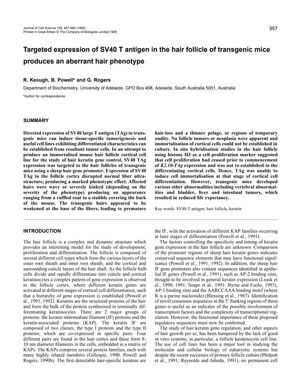Targeted Expression of SV40 T Antigen in the Hair Follicle of Transgenic Mice Produces an Aberrant Hair Phenotype
March 1995
in “
Journal of cell science
”

TLDR SV40 T antigen in hair follicles causes abnormal hair and health issues in mice.
The study investigated the effects of targeted expression of SV40 large T antigen (TAg) in the hair follicles of transgenic mice using a sheep hair gene promoter. The expression of TAg disrupted normal hair fiber structure, resulting in wavy or severely kinked hairs, leading to a ruffled coat or stubble appearance. Affected hairs were weakened at the base, causing premature hair loss and thinner pelage. Despite these phenotypic changes, no follicle tumors or cell immortalization were observed. However, transgenic mice developed other abnormalities, including vertebral issues and tumors in the bladder, liver, and intestines, which reduced their life expectancy.



